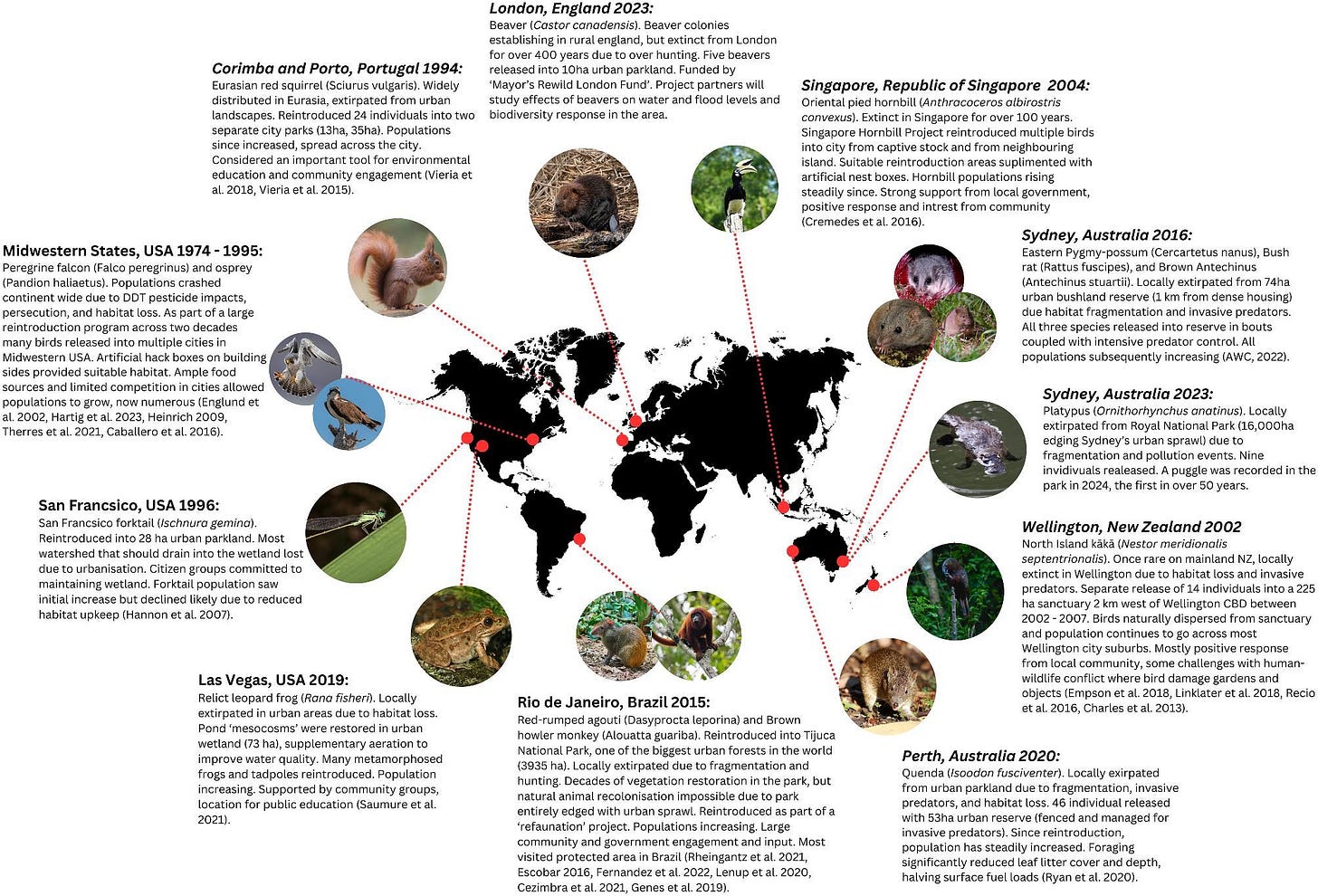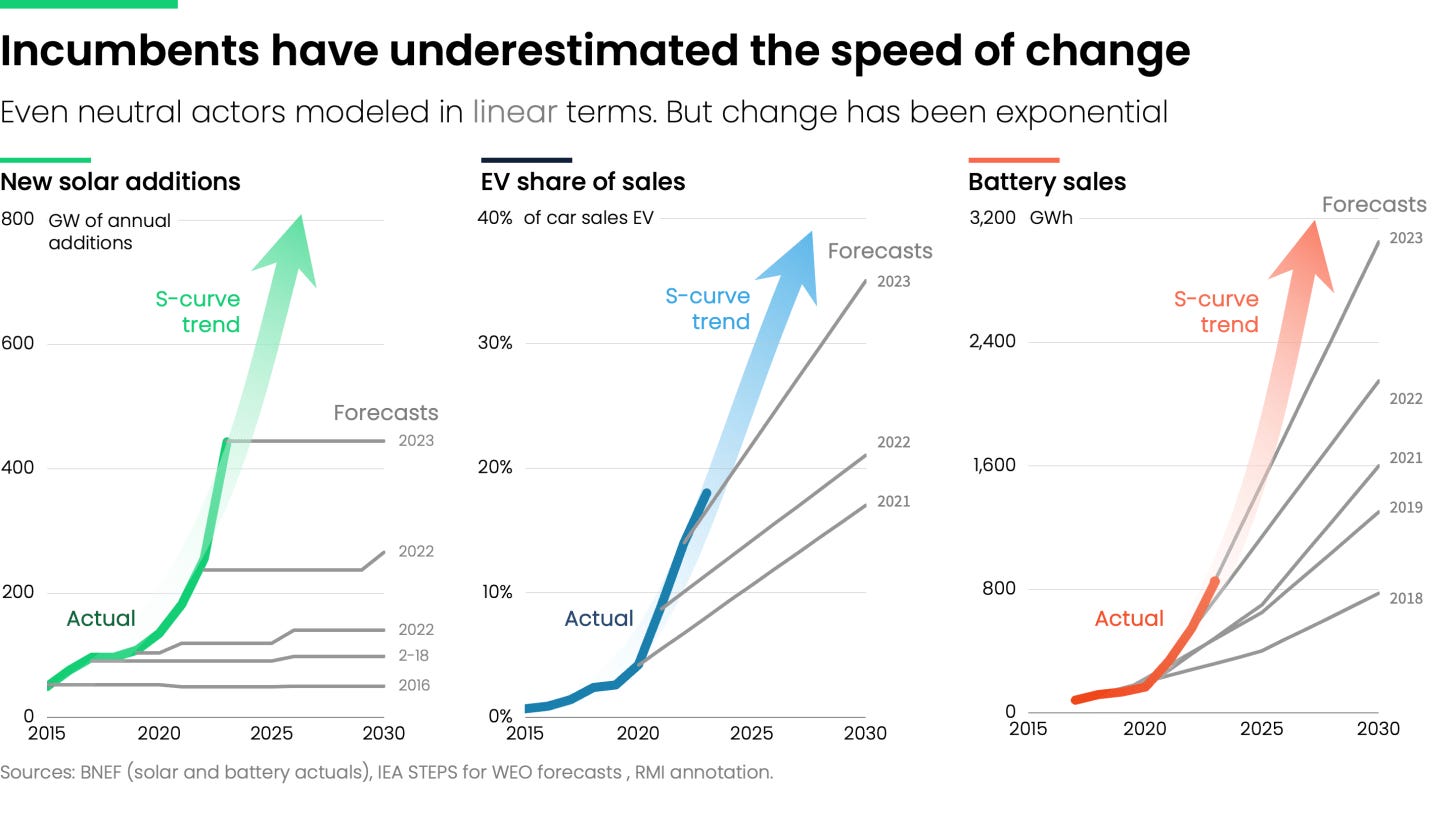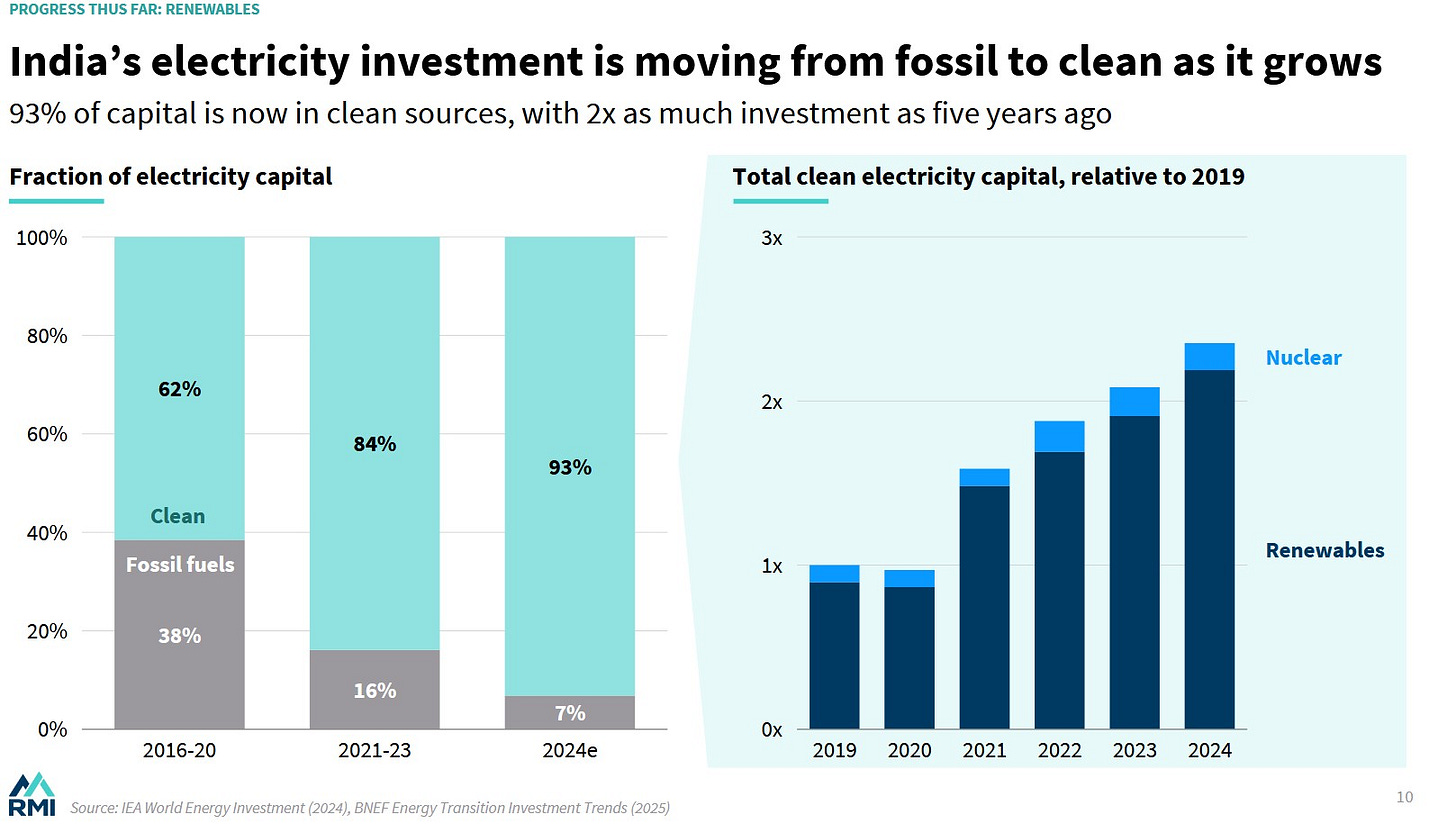The Weekly Anthropocene: June 4, 2025
Urban rewilding, electrotech advancing, jaguars in Sonora, ibex in Yemen, clean air in Paris, solar water pumps for tigers, investment flows in India, farm-bots, NEPA reform, and more!
The Big Picture: Urban Rewilding
Oxford University Press has published a milestone new paper discussing the worldwide emergence of urban rewilding, a longtime theme of this newsletter. The researchers reviewed 17 examples of human conservationists introducing terrestrial fauna into urban areas (not including the many other cases of wildlife making it in cities on their own!) and found that these urban rewilding efforts achieved their goals in 82% of cases, with marked “new populations booming!” success stories including hornbills in Singapore, leopard frogs in Las Vegas, platypuses in Sydney, howler monkeys in Rio de Janeiro, beavers in London, and many more. An awesome trend!
The Big Picture: Electrotech
The Rocky Mountain Institute has an excellent new article on the accelerating progress of the underreported worldwide “electrotech1” revolution! Check it out.
Mexico
Ranchers living around the Northern Jaguar Preserve in the northern Mexican state of Sonora are receiving payments for wild cat sightings on their land thanks to the Viviendo con Felinos program. A great way to incentivize community conservation!
A harpy eagle sighting in the southern Mexican state of Chiapas has been confirmed, the first time the iconic rainforest predator has been definitively seen in Mexico since 2011. Notably, three eagles were seen, potentially indicating a breeding population.
Scientists have rediscovered the Omiltemi cottontail rabbit (Sylvilagus insonus) in the mountainous pine forests of the Mexican state of Guerrero. The last confirmed scientific encounter was in 1904, and the species had been feared extinct. Great news!
France

Air pollution levels in Paris, France have fallen sharply since 2005, thanks to the city’s spectacular green urbanism efforts rapidly reducing car traffic and scaling up bike lanes and public transport. Lung-harming PM 2.5 levels have dropped by 55%!
French startup Gourmey has achieved a new milestone in lowering production costs for cruelty-free cell-cultivated meat thanks to their cutting-edge new bioreactor!
A world-first industrial-scale recycling facility focused on already-used polycotton fibers is set to be built in Saint-Avold, France, run by U.S. startup Circ. A mix of polyester and cotton, polycotton fibers are a “fast fashion” staple that is notoriously difficult to recycle. The new factory, which should be operational by 2028, will use a chemical process to separate the fiber materials back into two streams, which can then be recycled. Circ chose to locate the project in France due to crumbling U.S. support and steady EU support for cleantech development.
Some updates from the rising Solar Age in France:
French company Rossini Energy is now selling EV charging stations and solar parking lot canopies made with locally sourced Douglas fir wood.
French startup Heliup has completed a factory for lightweight rooftop solar panels, with 100 MW of annual production capacity.
Chinese manufacturer DAS Solar announced plans to build a 3 GW (3,000 MW) solar module assembly factory in eastern France.
About 1,407 MW (1.4 GW) of new solar power was connected to the French grid in January-March 2025, up from about 1 GW in Q1 2024 and bringing the nation to a cumulative total of 23.5 GW. Another record solar build-out year is likely on the way!
Yemen
In the Hadramawt province of war-torn Yemen, one former hunter named Abdullah Ahmed Salem Mawla al-Dawila runs a self-built and self-funded wildlife sanctuary that is home to over 50 Nubian ibex (Capra nubiana) and over 20 Arabian gazelles (Gazella arabica). Both imperiled species are native to the area and are now successfully breeding in the painstakingly landscaped enclosures. Incredible work!
Chile
Researchers in drought-stricken Chile have successfully trialed the revolutionary new “Jaspe” strain of rice, which can be grown with irrigation instead of flooded paddies and thus can use half as much water or less. It also has higher yields! Superb work.
Chile’s epic solar boom continues, with the Libélula solar/storage project breaking ground! It’s set to feature 199 MW of solar (sporting sun-tracking gear made with decarbonized steel from an electric arc furnace) plus 208 grid-scale batteries.
India
The Earth’s Brigade Foundation has installed 170 solar-powered water pumps in 25 protected areas (including 13 tiger reserves) across 7 Indian states, in order to provide a steady water supply for wild animals in a fast-drying climate. Spectacular work!
A new census has found that the Asiatic lion population has risen from 674 in 2020 to 891 individuals in 2025, now living across the Indian state of Gujarat. Great news!
The government of India has launched a cutting-edge new supercomputer-powered weather model, the Bharat Forecast System, with the goal of making more precise and localized predictions of rainfall to help prepare for disasters and empower farmers to time their planting activities. The country plans to more than double its weather radar network in two years to gather more data to fine-tune the model.
India installed 16.9 GW (16,900 MW) of new utility-scale solar power in the Indian fiscal year ending on March 31, 2025 — up 47% year-on-year. The world’s most populous nation also installed 5.1 GW of new rooftop solar power, a 72% increase!
The renowned Rocky Mountain Institute has an excellent new “Empowering India” report highlighting the rapid growth of and incredibly high future potential for clean energy to power fast-developing India. 93% of electricity investment capital now goes to clean electricity, and the amount has doubled since 2020 as building new solar in India becomes cheaper than running existing coal plants. Another sample statistic: just ten months in 2024 saw rooftop solar capacity across India double and rooftop solar capacity in the holy city of Varanasi multiply by 15 times! Great work.
United States
Though madness and malice continue to drive executive policy while the Senate debates a horror-budget, people across America still strive to build a brighter future!
Atlanta startup Ground Control Robotics has invented a new centipede-like robot designed to automate weed control around tangled, vine-like, or bush-like crops including blueberries, strawberries, and grapes. These relatively inexpensive farm-bots use AI to identify weeds, and a decentralized swarm of them could be customized to remove weeds through any of several methods, including physically uprooting them with grippers, spraying herbicides, or even firing small-scale lasers. Amazing work!
California is seeing new record highs in renewables generation and battery storage! On May 20, 2025 around 7:45 PM, batteries hit a new peak simultaneous output to the state grid of over 10 GW, becoming the largest source of electricity. And on May 21, renewables produced over 28 GW of power around 1 PM — when the state was only consuming around 21 GW, creating more surplus for the batteries to store. Great!
Several truly terrible bills that would have snarled fast-growing renewable energy (but not fossil fuels) in unnecessary red tape have finally died in the Texas state legislature!
Hawaii has passed a new law that imposes an extra 0.75% tax on hotel room stays and vacation rentals, set to generate $100 million each year. The revenue from this will be used for climate resilience projects including replenishing sand on eroding beaches, deploying roof-securing hurricane clips, and clearing highly flammable grasses.
The Ground Score Association collective in Portland, Oregon is successfully providing low-barrier employment to homeless people by paying them to collect trash and recyclable waste. They now have so many applicants that a lottery determines who will be hired each day, and a Grist reporter found that three people credited the program with saving their life by providing purposeful and honorable paid work.
Iowa startup Talusag is working to build out a solar-powered factory in the town of Eagle Lake that will create ammonia fertilizer from water and air, reducing fossil fuel use and regional dependence on shipping in fertilizer from elsewhere.
A newly passed law in Ohio was intended to promote fossil gas development, but experts say that in practice the bill’s language will likely incentivize more solar power in the state thanks to technology-neutral tax credits for building new power plants. This is another great example of what state-level pro-abundance policy can look like in practice, and that permitting reform these days tends to disproportionately benefit the build-out of ever-cheaper renewables even if it’s meant to prop up fossil fuels!
In May 2025, New York startup Aircela successfully demoed a prototype world-first fridge-sized electricity-powered direct air capture machine that synthesizes vehicle-ready gasoline fuel from thin air, assembling hydrocarbon molecules from the carbon dioxide in the atmosphere in a self-contained, “install-anywhere” process. When burned in any internal combustion engine, this does release CO2 again — but it’s just recirculating carbon that was already in the atmosphere, not adding more carbon that was previously locked underground. This opens up fascinating possibilities, from a household-level “rooftop gas station” to an oil rig-replacing array of gasoline-producing Aircela machines powered by a nearby solar farm. Incredible work!
On May 29, the U.S. Supreme Court ruled on the Seven County Infrastructure Coalition v. Eagle County case, deciding unanimously (8-0, with one justice recusing himself) to substantially limit the scope of the National Environmental Policy Act. Counterintuitively, in the medium to long-term this is a major environmental victory!
The specific Uinta railway project at the center of this case (held up for years by a mushrooming permitting process created by years of broadening the scope of NEPA) encapsulates the dichotomy. The Uinta railway would be built primarily to carry crude oil, benefiting the fossil fuel industry, but it would also be the first major new railway of any kind built in the United States since the 1980s. Reining in NEPA and removing easily hijack-able “veto points,” especially the endless lawsuits demanding lengthier NEPA project reviews, will make it much easier to build future railways, as well as solar farms, wind farms, geothermal wells, absolutely vital power transmission lines, and a lot more clean infrastructure that we badly need. This decision is a big win in a small loss’s clothing. It effectively accomplishes via court order one major goal of the proposed 2024 permitting reform compromise that this newsletter strongly but unsuccessfully advocated for at the time (check out my full article).
I suspect it will be difficult for much of the environmental and climate movement to celebrate limits on NEPA, because for decades much of it has been built on trying to use those veto points to stop fossil fuel development and other harmful projects. But the world has changed. A vast majority of the new stuff getting built these days is an improvement on the status quo and will help retire fossil fuels faster. Zero-carbon energy, mostly solar, accounted for 97% of new electricity-generating projects coming online in the U.S. in 2024! And NEPA-based lawsuits have repeatedly been used to block vital clean energy projects over and over again, often serving as essentially a faux-green fig-leaf for fossil fuel interests to delay building the oncoming competition.
The fact that the Uinta project would give a short-term local benefit to oil production arguably made it an excellent “Trojan horse” to get conservative justices to sign on to what is effectively an early policy achievement for the proposed Abundance Agenda. NEPA reform needed to happen. Even if this decision’s benefits mostly start under a saner administration in 2029, this writer expects that it will be a net benefit for clean energy and emissions reduction even in the short term: making it easier to build in the United States will overwhelmingly benefit the transition to renewable energy and help reduce emissions faster2. Spectacular news!
The article makes a strong case for using the more precise term “electrotech” to focus on fast-growing solar, battery, and EV tech as distinct from the broader term “cleantech,” which also includes some not-very-fast-growing “dead ends” like hydrogen-burning.
To be clear, I’m sure that many politicians will also try to exploit this decision to prop up fossil fuels more and empower the ridiculous “statist deindustrialization” energy policies of the current administration, but I would bet that the economic superiority of clean energy is now so overwhelming (and that the trade chaos damage to U.S. fossil fuels is so substantial) that even if this NEPA reform decision was partially intended to benefit fossil fuels, it will still end up benefiting clean energy and emissions reduction on net!

















It's interesting reading some of the counterintuitive (or intentionally subversive and clever) ways that some of the seemingly pro-fossil fuel / conservative policies are actually being leveraged for positive change. It is so exciting to hear that we're finally building rail again!
I found a mistake… The beaver that’s reintroduced in the UK is not Castor canadensis, but the Eurasian beaver, Castor fiber. I’m surprised at the publisher…don’t give the graphics to the intern to do, or an overextended grad student.